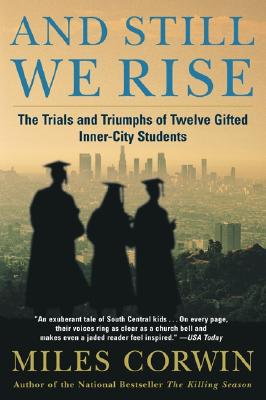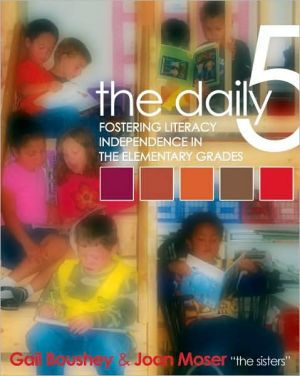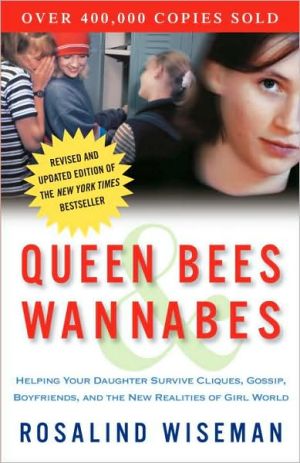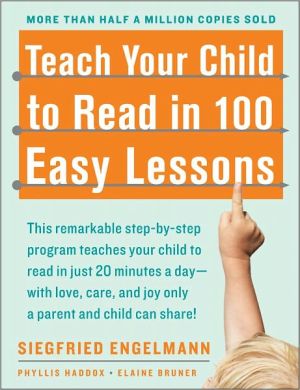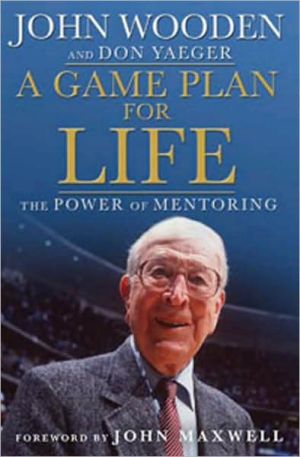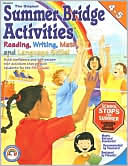And Still We Rise: The Trials and Triumphs of Twelve Gifted Inner-City High School Students
Bestselling author of The Killing Season and veteran Los Angeles Times reporter Miles Corwin spent a school year with twelve high school seniors — South-Central kids who qualified for a gifted program because of their exceptional IQs and test scores. Sitting alongside them in classrooms where bullets were known to rip through windows, Corwin chronicled their amazing odyssey as they faced the greatest challenges of their academic lives. And Still We Rise is an unforgettable story of...
Search in google:
Author and journalist Miles Corwin spent the entire 1996-97 school year with a remarkable group of individuals: the students in the senior Advanced Placement English class at Crenshaw High School—-young ghetto scholars who have managed to excel despite living in the hostile world of South Central Los Angeles. This book is a moving account of their courage, achievements, strength, and resilient spirit—-their personal crises, setbacks, catastrophes, and triumphs. It is an unforgettable ten-month visit to the dynamic, electrically charged classroom of Toni Little, an inspiring but volatile and wildly unpredictable white educator determined to imbue her minority students with a passion for great literature. Corwin also spent the year with Anita "Mama" Moultrie, a flamboyant black teacher whose Afrocentric teaching style was diametrically opposed to Little's traditional approach. These exceptional students—-all classified as gifted—-provide a ground zero perspective on the affirmative action debate and will remain with the readers always. Publishers Weekly Los Angeles Times reporter Corwin offers a viscerally affecting glimpse inside the world of an inner-city high school. Hewing to the approach of his first book, The Killing Season: A Summer Inside an LAPD Homicide Division, he followed the seniors in an Advanced Placement (AP) English class from their first day of school in 1997 to graduation. Overcrowded, underfunded Crenshaw High School has a dropout rate of almost 50%. Notorious as the setting for the movie Boyz 'n the Hood and as home base for one of L.A.'s worst gangs, Crenshaw is located in the impoverished and crime-ridden South-Central district. The struggling students whose stories Corwin adroitly interweaves face trying circumstances: some have parents on welfare, in prison or addicted to crack; many work at part- or full-time jobs; several cope with the scarring effects of physical or sexual abuse. Yet most minority students in Crenshaw's "gifted magnet program" manage to get As and go on to college. Corwin succeeds admirably in avoiding the cliched image of inner-city schools, with wide-eyed, altruistic teachers and menacing students. For example, he describes Toni Little, the white AP English teacher (nearly all of whose students are black), as a volatile, histrionic personality who frequently involves students in her bitter ongoing battle with administrators. California voted to end affirmative action in 1997, and Corwin passionately argues that affirmative action programs are an imperfect but necessary measure to level a grossly uneven playing field. His profiles of high achievers who shun the temptations of the street are sure to inspire. Agent: Barney Karpfinger. (Apr.) Copyright 2000 Cahners Business Information.\|
Olivia\ \ I Don't Want Her\ \ During the years of beatings by her mother, years of being whipped with an extension cord, smacked in the mouth with a telephone, pounded against a wall, punched in the lip, dragged by the hair through the hallway, tossed in the shower, and scalded with hot water, school was Olivia's salvation. The only kind words she heard, the only love she felt, the only compliments she received, were from her teachers. At home, no matter how she was tormented, no matter how long she cried, when the beatings were over, she always read her assignments, and prepared for her tests.\ Olivia had always excelled in school and was always one of the brightest students in her class. And the As she strived for and always received enabled her to find a glimmer of happiness and hope during an abysmal childhood.\ But when Olivia began the seventh grade, even the diversions and distractions of school were no longer enough. The beatings were now a daily torment. Each evening, when her mother returned from her job as a hotel maid, she always found a reason to beat Olivia. If Olivia's face was bruised, or her lip was split, her mother would tell her to say at school that she fell off a bicycle.\ Olivia's stomach churned as she waited for her mother to walk through the door. She was terrified by the image that she knew would confront her: her mother's eyes wild, mouth wide open in a rictus of rage, shouting, "I hate you!" or "I wish you were never born!" and then spitting at her and dragging her around the house until carpet burns covered her body. Olivia could never understand why her mother seemed to detest her; shecould never figure out exactly what she did to warrant yet another beating. When Olivia was a little girl she was convinced her mother was possessed by the devil. Her only respite from her anguish, her only reprieve from the beatings, she decided, was suicide. At school, she daydreamed about hanging herself, or swallowing an overdose of pills, or slashing her wrists.\ But one afternoon after school, when her mother left for work, Olivia decided to run away instead. She ripped out of the Yellow Pages the shelter listings for abused children and battered women. She stuffed them in her back pocket and filled a duffle bag with clothes. Then, as an afterthought, she grabbed her mother's black leather jacket. Olivia had always been cowed into absolute obedience, and this was a final act of absolute defiance that meant to Olivia that she was never coming back, that, at twelve years old, she was forever severing the bond with her mother.\ It was a windy March afternoon, and when Olivia stepped outside, she zipped up the jacket and ran until she was exhausted. At a busy intersection, she spotted a phone booth. She pulled out the list of shelters from her pocket and called a few, until she found one that agreed to pick her up. At dusk, she sat in the phone booth, cross-legged, and watched the light fade from the sky. Finally, two men in a van showed up and asked Olivia her name.\ "I can't give you my name," she cried. "You'll just take me back to my mother. She'll kill me! Please don't make me give you my name." Olivia burst into tears. The men assured her that she was safe and drove her to a downtown shelter. That first night she shared a room with another girl and felt both relieved and frightened. Relieved that no one had called her mother. Frightened that someone might call her mother the next day and she would be sent home.\ She spent ten days at the shelter before a social worker arranged a meeting with Olivia and her mother. Olivia recounted the beatings and the abuse. Her mother interrupted her and shouted, "She's making it all up! She's a liar!" Then she lunged at Olivia, and several shelter staff members had to restrain her.\ A few months later a court hearing was held to determine Olivia's fate. She felt as if she were in a fog as the judge and social workers discussed her case. She remembers only the end of the hearing, when the judge told her mother that if she wanted the opportunity to regain custody of her daughter, she would have to undergo psychological testing, individual counseling, and family counseling. Olivia's mother told the judge, "She's the crazy one. Not me." The last words Olivia remembers her mother saying were, "I don't want her!"\ Olivia was made a ward of the county. Her social worker told her she would be placed with a foster family, but there were no openings, so she was sent to a group home where six other girls were living. During the next few years, Olivia was shuttled between a series of Dickensian group homes and foster homes in South-Central Los Angeles. (A group home is an independent business with a hired staff; a foster home is a private house headed by a foster parent who lives there.)\ At one group home, a supervisor only let the girls take showers every three days. At a foster home, during the heat of the summer, the foster mother locked the girls in their rooms all day. At another, the girls had to purchase their own food. At a group home, the girls kept stealing Olivia's clothes, and one wild-eyed girl chased her around the house with a hot iron. By the time she was sixteen, she had lived in ten different group or foster homes.\ Olivia always felt she was an outsider. Her father, half black, half Cuban, barely played a role in her life. Her mother is Mexican. But Olivia considers herself black, partly because she has spent so many years living with black girls and black foster mothers and attending predominantly black schools. The other girls at the homes, however, never let Olivia forget her mixed heritage. And Olivia was always the only girl who cared about school, who did her homework, who dreamt of attending college. While Olivia was a precocious and articulate child, her housemates often were surly and monosyllabic girls who counted the days until they could drop out of high school, who talked about getting pregnant and living off welfare. Olivia spent more time chatting with the adults at the homes than with the girls.\ When Olivia was about to start high school, a rare, compassionate group-home administrator gave her a pamphlet that listed the magnet schools in the Los Angeles school district. These schools were for students who had an interest in a particular field of study, or who had a talent for music or art, or who were classified as gifted because of their high IQ or standardized test scores. Olivia studied the pamphlet and discovered that one of the two high schools in the city for gifted students was located at Crenshaw High School, only a few miles from her South-Central group home.\ One afternoon, she took the bus from her junior high school to Crenshaw and talked to several administrators. They told Olivia that her IQ and her standardized test scores which were in the top 5th percentile of the nation-were well above the minimum requirement. She enrolled in the gifted magnet program in the ninth grade.\ Crenshaw is an overcrowded, underfunded South-Central high school where two school district policemen armed with 9mm pistols patrol the grounds and where several neighborhood gangs fight for control. It is a high school where half the students come from families eligible for welfare, where about 90 percent participate in the federal free lunch program, where the dropout rate is almost 50 percent, and where only 4 percent of the seniors score above average on college aptitude tests. Known as "Da Shaw," it is one of the city's most notorious high schools. Crenshaw was the setting for the movie Boyz N the Hood, the alma mater of rapper Ice T, and the home base for the Rollin 60s, one of the city's most notorious street gangs.\ The gifted magnet program, however, was a refuge for Olivia, and she immediately felt comfortable in the program. She met many other students who, like her, had wretched childhoods, yet had managed to stay focused on school and retain a love of learning. Olivia thrived in the...
\ Publishers Weekly - Publisher's Weekly\ Los Angeles Times reporter Corwin offers a viscerally affecting glimpse inside the world of an inner-city high school. Hewing to the approach of his first book, The Killing Season: A Summer Inside an LAPD Homicide Division, he followed the seniors in an Advanced Placement (AP) English class from their first day of school in 1997 to graduation. Overcrowded, underfunded Crenshaw High School has a dropout rate of almost 50%. Notorious as the setting for the movie Boyz 'n the Hood and as home base for one of L.A.'s worst gangs, Crenshaw is located in the impoverished and crime-ridden South-Central district. The struggling students whose stories Corwin adroitly interweaves face trying circumstances: some have parents on welfare, in prison or addicted to crack; many work at part- or full-time jobs; several cope with the scarring effects of physical or sexual abuse. Yet most minority students in Crenshaw's "gifted magnet program" manage to get As and go on to college. Corwin succeeds admirably in avoiding the cliched image of inner-city schools, with wide-eyed, altruistic teachers and menacing students. For example, he describes Toni Little, the white AP English teacher (nearly all of whose students are black), as a volatile, histrionic personality who frequently involves students in her bitter ongoing battle with administrators. California voted to end affirmative action in 1997, and Corwin passionately argues that affirmative action programs are an imperfect but necessary measure to level a grossly uneven playing field. His profiles of high achievers who shun the temptations of the street are sure to inspire. Agent: Barney Karpfinger. (Apr.) Copyright 2000 Cahners Business Information.\|\ \ \ \ \ Bob Blaisdell...readers have to be grateful for the abundance of classroom dialogue that is unexpected, fresh and interesting, and fine portraits, as good as fiction, of two teachers and one student. \ —The New York Times Book Review\ \ \ Kay Mills[A] splendid new book...Like (Jonathan) Kozol, Corwin can stop you with a moment from his time at Crenshaw, whether it's the day that Toya, for whom school had been the only sanctuary and for whom her teachers had such hope, shows up with her 10-day-old baby, or when a teacher, Toni Little, rails against a school system that makes her teach too many Advanced Placement English students with too little means to provide classroom materials.\ —The Los Angeles Times\ \ \ \ \ Kirkus ReviewsA year in an English class in an inner-city public high school. In the Gifted Magnet Program at Crenshaw High School in South-Central Los Angeles the Advanced Placement students face not merely the academic privileges of competition and interaction with their intellectual peers. They face multiple pressures that would debilitate and demoralize the average adult: poverty, crime, emotional and physical abuse from family members, gangs, drugs, peer pressure, and bureaucratic entanglements whose outcomes will determine their day-to-day survival. Corwin (The Killing Season, 1997) monitored the unfolding 1996-97 academic year with the AP English class at Crenshaw. It was not the best of times, in many regards: the teacher in charge of the class was enmeshed in her own struggle to maintain her professional and emotional focus just then, and the ongoing movement to end affirmative action in public education was facing a statewide vote on that fall's ballot. Whether following the travails facing the vividly characterized students or those facing the class instructor, Toni Little, Corwin kept his own journalistic focus throughout a project that presented professional and ethical challenges of the most exasperating sort. He details the subsequent defeats and triumphs of will and discipline and keeps the story gritty and gripping, even when explaining the history that led to Proposition 187 (the initiative to end affirmative action) or relating the intimate connection between one of the students at Crenshaw and the two black athletes who raised their fists on the victory stand at the 1968 Olympics. Readers might question Corwin's role in the early part of the narrative; he preparesthem forthe moment when the barrier between objectivity and action dissolves late in the story. The stakes here are comparable to those in the documentary Hoop Dreams, and Corwin manages to give academic failure and triumph the same dignified solidity. Reportage of the highest order.\ \
